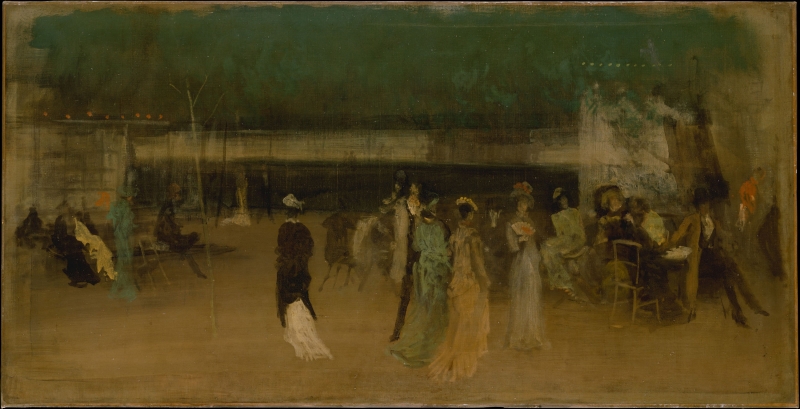Titles
One title predominates:
'Cremorne Gardens, No. 2' is numbered '2', as following Cremorne, No. 1 [YMSM 163], although there is no way to know which was painted first.
Description
This is the largest of six nocturnal paintings of Cremorne Gardens, Chelsea. It is a view of a broad piazza, with many figures in evening dress walking and sitting around it. In the distance there is a low building with boxes or pavilions, against a dark sky or trees. In the middle distance at left and right are trees and taller buildings decorated with rows of lights. The canvas is in horizontal format.
Site
Cremorne pleasure gardens in London, closed to the public in 1877. Whistler's paintings of Cremorne include Cremorne, No. 1 [YMSM 163], Cremorne Gardens, No. 2 [YMSM 164], Nocturne: Cremorne Gardens, No. 3 [YMSM 165], Nocturne in Black and Gold: The Gardens [YMSM 166], Nocturne: Black and Gold - The Fire Wheel [YMSM 169], and Nocturne in Black and Gold: The Falling Rocket [YMSM 170].
Sitter
Way & Dennis suggested that the man seated on the extreme right was Whistler, but, as A. E. Gallatin pointed out, the absence of any features makes this a highly speculative identification! 3
Comments
MacDonald discussed Whistler's 1870s compositions, including Cremorne Gardens, No. 2, comparing it to contemporary fashion plates:
'Lithographic crayon was eminently suited to showing the design and texture of costume and became a popular alternative to engraving for fashion plates. Myra’s Spring Panorama of Paris Patterns and Models for May 1878 is a delightful example: a triple-page pullout showing no less than fourteen dresses with narrow hobble skirts and magnificent trains. The similarity in mood and detail to the silky trailing dresses of the pleasure seekers and prostitutes in Whistler’s Cremorne Gardens is striking. Whistler lived within sight of Cremorne in Chelsea, and sat there on summer evenings, like the dandy in top hat and frock coat who is a cool observer of the scene. The dresses invite comparison with Whistler’s portraits of Maud, Louise Jopling, and Frances Leyland. The scene conjures up memories of Watteau, and above all, Gainsborough, whose delicate rendering of The Mall in St James’s Park [Frick Collection] hung in the Royal Academy in 1876 - and who was, Whistler and Fantin-Latour agreed, one of "our old loves".
In Cremorne Gardens, Whistler stroked and scraped pale colours – flesh pink and blues - over the canvas to suggest silky draperies. To achieve similar effects in silvery grey, he exploited the textural possibilities of lithography, using crayons of varying hardness and degree of point, as precise as pencil or soft as charcoal.' 4
The Metropolitan Museum of Art website comments:
'The French Impressionists, whom Whistler knew, also portrayed outdoor public entertainments in parks and resorts, as Claude Monet did in 1869 in La Grenouillère (29.100.112). In contrast to the Impressionists, however, Whistler sought to emphasize a harmonious world on the canvas, not simply to record the world of appearances. As Cremorne Gardens was associated with the demimonde, the painting may refer to an encounter between four prostitutes and a potential customer. Whistler's principal goal, however, was to imply with his brilliantly colored, ghostlike forms the ephemeral charm of an evening's gathering in the veiled atmosphere of an indistinct setting rather than a legible narrative.' 5
Notes:
1: Memorial Exhibition of the Works of the late James McNeill Whistler, First President of The International Society of Sculptors, Painters and Gravers, New Gallery, Regent Street, London, 1905 (cat. no. 25).
2: YMSM 1980 [more] (cat. no. 164).
3: Way & Dennis 1903 [more] , p. 61, repr. f.p. 60. Gallatin 1913 A [more] . pp. 7-8.
4: MacDonald 2003 [more] , pp. 138-39, fig. 128.Quotation, Whistler to Fantin-Latour, 'nos anciens amours', [29 June 1859], GUW #08050.
5: Metropolitan Museum of Art website at http://www.metmuseum.org/toah/works-of-art/12.32.
Last updated: 23rd October 2020 by Margaret






